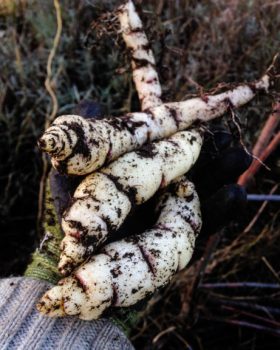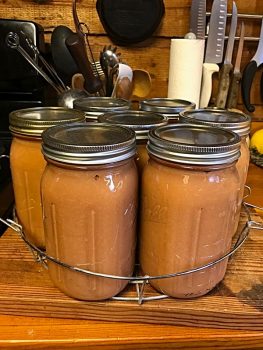Gathering… it’s a great word for this time of year.
A gathering of fruits, roots, herbs, seeds, friends, thoughts… I have always been a hunter-gatherer. This is one of my favorite times of year.

Autumn is all about timing – timing the harvests, clean-ups, bringing in the plants that need protection, putting away hoses and tools, planting shrubs and trees, and mulching mulching mulching! – timing the to-do list between rain showers, knowing that clear sunny days are often cold, followed by frosty nights and mornings. On the rainy days, we turn inwards – warming the kitchen with preserving fruits, making assorted concoctions with our herbs, crafting gifts for the upcoming holidays…
Fall is the season for gathering roots and squashes. A hard frost in early October cut short the growing time for the mashua roots (Troepaeolum tuberosum), but we still managed to harvest enough to carry on the crop (plus, I had planted them in more than one place, so it was a good opportunity to take a close look at the microclimates: sunnier spots often get hit with the hardest frosts!). I found a great crop of Ozette potatoes that had volunteered beneath their vines.

Squashes also surprised me, venturing beyond my imaginary borders, sometimes up and over shrubs and into trees. The Lower Salmon River squashes, a regional heritage variety, were particularly beautiful intertwined with nasturtiums. The Malabar was quite adventurous, journeying deep into the shady area of the willow room, dropping melons in the shelter of over-reaching shrubs along the way. They also climbed up through the branches of the Cornelian cherries and the quince, where we found large fruits dangling in the dappled light behind leaves. These fruits, I noticed, did not do as well as those on the ground (which grew massive!). My theory is that the vines on the ground can send out roots along the stems and thereby get extra moisture and nutrients, whereas those in the trees must survive in mid-air.


Although we got fewer apples this year, we still had plenty for sharing. The kitchen smells wonderful while I keep the canner going with an assortment of jams and sauces – apple, quince, strawberry tree fruits (Arbutus unedo), and Cornelian cherries, with hints of cinnamon, ginger, and vanilla. Alternating fruits and herbs in the dehydrator add their own sweet and woodsy notes. What if we were to describe our homes like a wine label?
November Gathering depends on what’s out there…
“What can we still find in the garden?” I asked my 3-year-old granddaughter the other day. “Let’s go see.” She probably thought her grandma was full of wishes (and I am!), but as it turned out, we found a lot!
Although all around us were the brown stems and seeds of tall grasses and weeds, fennel heads, hollyhock, chenopodium “goosefoot,” and assorted spent flowers, all is not gone. The ground is carpeted with leaves from alder, cottonwood, apple, and willow; it is definitely fall. I get down to her level to see what the world looks like – and yes, walking through my garden can be a challenge, although being a little has its advantages, too! I lift her up and over some of the tangles.
We stop to eat the last of the autumn olives; the birds did not leave me many this year, so the few remaining are a sweet and tangy treat. We find sage, rosemary, thyme, and oregano – and she closes her eyes and deeply inhales each fragrance, almost swooning. “Ahhhhh!”

At the big wild rose bush near the garden’s edge, we fill our bowls with the bright red hips. Each one is a precious jewel. There are so many! “Oh my goodness!” she exclaims. We leave a lot for the birds.
Next we go to the evergreens and pick a few tips of grand fir, which we found to be the most lemony tasting; we don’t need many.
On the way back, she recognizes some calendula blossoms and picks one, but leaves the rest for the bees. We talk about how it can be hard for bees to find food at this time of year.
Lastly, we take a few branches from the Bay shrub (Laurus nobilis). We only need a few for cooking but will pick more later for wreaths. The shrub, started from seed, is now taller than our barn and covers my entire shop window. It definitely needs a little pruning this winter.

The gathering makes a nice assortment, I think!
Back at the house, we put the rose hips in some water to very gently simmer on the stove. Later we will strain them through muslin to get rid of any tiny potentially irritating hairs, then sweeten the elixir with honey and top with brandy.
Most of the other herbs we put in the crockpot, along with frozen black hawthorn berries (Crataegus douglasii) from earlier in the year. I have been told that freezing them helps to break down the cell walls, making the medicinal extraction more efficient. It makes sense to me. My goal is to make something good for the heart and that will be nourishing through the winter cold season. It will make nice gifts in time for the holidays.
The house smells like a forest! We simmered it all for several hours and then let it soak for a few days more. Then we squeezed out all the juice, added honey and brandy. I think it will keep us well through the winter! Here’s what we did:
Hawthorn-Fir Herb & Spice Tonic
- 2 lbs (~8 c) frozen black hawthorn berries
- 2 c frozen cranberries
- 4 oz fresh sage
- 2 oz fresh oregano
- 2 oz fresh rosemary
- 3 oz grand fir needles
- 1 orange peel (scrubbed & cut in pieces)
- 3 c water
- 5 whole star anise
- 2 small cinnamon sticks
- 10 whole allspice
- 8 whole cardamom pods
- 10 whole cloves
- 5 large (but thin) slices of ginger
- 1 1/2 c honey
- 1 1/2 c of brandy
- Put the frozen berries in a large crockpot (I confess – I added the cranberries because I had them)
- Blend the fresh herbs and orange peel in a blender with the water, just enough to break them up a bit – or just chop the herbs and orange peel into pieces. Add to the crockpot.
- Stir in the spices, including the ginger.
- Let it cook on low for several hours or overnight. It should be hot but not boiling. Mine wasn’t even simmering.
- Let it all sit and soak for several days until you get around to dealing with it. (When the sun comes out, I work outside.)
- Strain everything through several layers of cheesecloth or muslin, being mindful to get out as much as possible. I ended up with about 6 c of liquid. My original plan was to add equal parts decoction, honey, and brandy – but ooh boy, that could be a lot and I didn’t really want to go buy more alcohol. I figured half again as much honey and brandy would still work (i.e., 3 c of each), but that still amounts to an overflowing half gallon of the stuff. So I decided to reduce it all down (next step).
- Simmer very gently the squeezed out juice/tea mixture to reduce the liquid to about 3 c.
- Now add 1/2 the volume of both brandy and honey – which, doing fuzzy math, means you get about 6 c tonic, which must be divided between a quart and a pint jar. Perhaps at this point I should have just put it all in a half-gallon jar and stirred it all up and then divided it – but I couldn’t find an empty one – so, true to my way of making things complicated, I put 1 c of decoction in a pint jar and added 1/2 c honey; gave it a good stir to mix it up; then added 1/2 c brandy. Then I did the same thing with a quart jar, only this time, obviously, put in the remaining 2 c of the decoction/juice blend and 1 c of honey – gave it a good stir (this just makes it easier to mix without splashing) – and then added the additional 1 c brandy.
- Cap both jars (I used non-metallic lids) and let them sit for however long you can, but I think the usual recommendation is 4-6 wks.
I know this looks complicated – and it aptly illustrates why I am NOT a food blogger! – but the reality is, you go out and gather what you have, simmer it together with some berries or other fruits, strain it and combine with honey and alcohol. Bam! If I were to do it over and had more time, perhaps I would soak the berries in alcohol first, strain it, and then add the strong herbal concoction. Also note – I tried to keep the heat to a minimum, which is important in preserving antioxidants and vitamins. The tonic should keep fairly well because of the alcohol and honey.
If you decide to make this, how much to take is up to you. I would think 1/2 tsp 3x/day would be a good starting point. It makes it sound like you are doing it for medicinal purposes, which perhaps you are. Of course, this post is not meant to replace any kind of medical advice; it’s just sharing what I made. I admit, I think it turned out pretty good! Small, repeated sips seems appropriate!
Moving Right Along….
The next few days were cold and windy, so it was good for more medicine making. Our counters were covered with assorted creations, too many to include in this post!

Today, though, was a perfect day for harvesting the Medlars (Mespilus germanica), most of which had fallen on the ground and were camouflaged amongst the orange and brown-speckled leaves. I got down on my hands and knees where I could smell the moist humus of the soil. It is a treasure hunt – you rustle about until you find the hard, round fruits. They look like giant rusty rose hips. There are lots! I should have brought a bigger box. I fill my hat and sweater with the extra fruits and soon will be making more jams, vinegars, and liqueurs. First, though, we have to let them soften (or “blet”), at which time, they have a somewhat mealy texture and a flavor of cooked apples. So very interesting!
November Gatherings. A time of great abundance. A time for sharing.

With gratitude,
Thank you.
~blythe